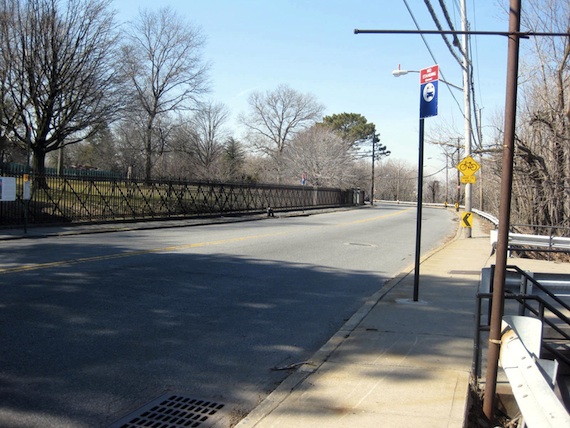Staten Island's North Shore is one of the city's great sites of opportunity. The neighborhoods along the Kill Van Kull are twice as dense as the rest of Staten Island, but lack any transit option beyond the bus. There are historic town centers at St. George and Port Richmond, but car-centric planning deadens street life. The waterfront, much of which still hosts a vibrant maritime industry, is only accessible to the public at three locations in six miles.
The opportunities aren't lost on the city. With the release of North Shore 2030, a plan put out in December by the New York City Economic Development Corporation and the Department of City Planning, the stage has been set for opening up the waterfront, fostering mixed-use development, and making streets safe and friendly for pedestrians and cyclists. Realizing the full extent of that vision, however, largely hinges on the success of plans to restore rapid transit to the North Shore.
To learn more about the plan, this Wednesday I headed over to the North Shore, where Staten Islanders Meredith Sladek and Nick Rozak took me on a half-day bike tour of the area. North Shore 2030 is a broad planning effort, looking at everything from transportation to bolstering the North Shore's significant maritime industry. At the center of the plan is a proposal to encourage traditional mixed-use developments, with residences on top of retail, along certain corridors, including Richmond Terrace, Castleton Avenue, and Victory Boulevard.
Pedestrian-oriented housing and commerce would be clustered in four "neighborhood centers." Along the North Shore, there are a number of older neighborhoods with walkable bones, especially where rail and ferry stations existed prior to the opening of the Verrazano Bridge. As Staten Island has shifted toward the automobile, however, those areas have fallen on harder times, with commercial activity moving into malls and shopping centers. At the corner of Port Richmond Avenue and Richmond Terrace, for example, one block from a former rail station and ferry terminal, older pedestrian-oriented buildings have shuttered windows and "for rent" signs. North Shore 2030 reimagines the intersection full of pedestrians walking between the waterfront, shops, and their apartments.

Revitalizing these areas will take more than zoning, though: The key will be restoring rapid transit service. Rail used to run along the North Shore and the tracks are still in place. In some locations, the right-of-way is still being used for freight transport; in others, they're overgrown with trees, or even underwater.

Currently, only buses run through the area. Despite the paltry transit options, 35 percent of people living west of the ferry terminal take transit to work: a number that's low for New York City but high considering the infrastructure in place, and indicative of the untapped potential to boost transit ridership. The MTA is studying plans to bring a half-billion dollar transit line back to the North Shore -- either light rail or bus rapid transit -- but with the evaluation incomplete and the agency's budget ever more strained, there's no guarantee the North Shore will actually see rapid transit and the development it can foster.
If built, the new routes would make transit a much more attractive option, cutting travel times in half or even up to two-thirds, according to the MTA, a potentially transformative effect. Feeding directly into the ferry terminal, the rail right-of-way would make it easy for North Shore residents to get into Manhattan. The very beginning of the rail line is already used for passenger service on days when the Staten Island Yankees are playing a home game.

One downside: The DCP/EDC report calls for new park-and-rides at the future transit stations. Those lots could turn the planned transit line from one that facilitates growth and revitalization around stations to something meant only to shuttle motorists more quickly to the ferry. Even on the Staten Island Railroad, which runs down the more suburban South Shore, only five stations have park-and-rides.

Even if rapid transit doesn't materialize on the North Shore, the bicycle and pedestrian improvements planned for the area should help people get around their neighborhoods safely without a car. Right now, the area's pedestrian infrastructure varies dramatically in quality. The Homeport site, a former Navy base shown above, is being redeveloped as a $150 million project with luxury apartments and retail. Right now, there aren't even sidewalks on that wide section of Front Street, which is just outside the North Shore study area. The 2030 plan calls not only for building sidewalks where they're missing, but also installing bulb-outs to extend existing sidewalks where traffic calming is needed for pedestrian safety.

Bus stops, in particular, are slated for improvements. This bus stop, located across from the historic mansions of Snug Harbor, is one of the more popular on the North Shore. There isn't even a crosswalk connecting the stop to the park across the street, however, much less a bus shelter to allow riders to wait in comfort. The blind curve of Richmond Terrace makes the crossing that much more dangerous.
DCP and EDC specifically identify this location as in need of a safe pedestrian crossing. In general bus stops are slated to get improved infrastructure, including new shelters.
Bicycle infrastructure, too, would get an upgrade under the North Shore 2030 plan. Currently, cyclists heading between the North Shore and the ferry terminal have very inadequate infrastructure. Just west of the terminal, there's a stretch of road labeled as greenway. Unlike the city's other greenways, however, cyclists here have to share the road with cars and trucks. "Vehicle priority" read the greenway signs.
After about a mile, the "greenway" turns inland and becomes an on-street bike lane for another half-mile before disappearing altogether. The city's plan calls for extending the bike infrastructure much further west, with a "multi-purpose pathway" extending nearly to the end of the island. The exact form of that pathway is unclear, but it would seem to be a significant improvement for cyclists riding in the area.

At the ferry terminal itself, the 2030 plan recommends creating a secure area for bicycle parking. Currently, outdoor racks are the best option for commuters who want to leave their bike on the Staten Island side of the harbor, and they aren't popular with many regular riders. With its heavy commuter traffic, the ferry terminal would be the perfect place to build a Chicago-style bike station. A small satellite bike-share system could also be set up around the ferry.

The city also wants to improve the pedestrian connection between the ferry terminal and the surrounding St. George area. The key will be improving the complicated and hostile intersection immediately in front of the terminal.
Staten Island is a borough of almost half a million people, more than Atlanta, Miami, or Minneapolis. There's no reason it can't have revitalized pedestrian neighborhoods built around a strengthened transit backbone, and the North Shore is the place to start. DCP and EDC's plans -- if they ever become reality, and if North Shore transit ever gets built -- would put it on the right track.










